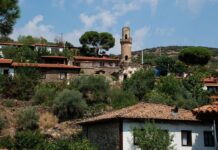Some historical writers described the moat of Constantinople as always filled with water, giving the city the appearance of being surrounded by the sea. But this claim raises an important question: Was it just poetic language, or was the moat really flooded all the time?
Other Ways Water Might Have Entered
If the moat was indeed constantly filled with water, it could not have relied only on the aqueducts that passed through it. Even Dr. Paspates, who believed in the role of aqueducts, admitted that these structures usually supplied water to the city, not to the moat.
Unfortunately, modern researchers cannot explore the moat or surrounding land easily because of debris, modern buildings, and gardens that cover the area. But one clue gives us hope: below the fifth aqueduct south of Topkapı Gate, a mouth of a tunnel can still be seen in the wall of the moat. This might be part of an underground channel that once brought water into the moat from outside the city The Gates of the Theodosian Walls.
If such hidden conduits carried water to high areas like Topkapı or Edirnekapı, the water could have then flowed downward with enough pressure to flood the rest of the moat.
Was the Moat Filled During War?
Even the idea that the moat was flooded during wartime only has some problems. First, during a siege, the city needed to save all its water for drinking, cooking, and sanitation. Using large amounts of water to fill the moat may not have been practical, especially if the siege happened during the dry season, as many did.
Second, historical accounts of sieges say very little about water in the moat. Writers from those times mention the moat often, but they do not say it was filled with water Daily Ephesus Tours.
Evidence from the 1453 Siege
A strong piece of evidence comes from the siege of Constantinople in 1453, described by the Latin poet Pusculus. He gives a detailed report of how the moat was prepared for defense, including how soldiers dug it deeper and raised earthworks beside it. But he never says that the moat was filled with water.
His words were:
“Fossaque cavant, atque aggere terrae educto, muros forti munimine cingunt.”
(They dug the moat and raised an earth rampart to strengthen the walls.)
If water had been added, Pusculus would likely have mentioned it, since it would have been a major defensive move.
The debate over whether the moat was permanently flooded, only filled during war, or usually dry remains unsettled. There is evidence for and against each view. Without the ability to dig and explore the ancient conduits and channels today, we can’t give a final answer. Future archaeological research might help solve this mystery. For now, we must rely on written sources and a little informed speculation to understand the true role of the moat in defending Constantinople.








